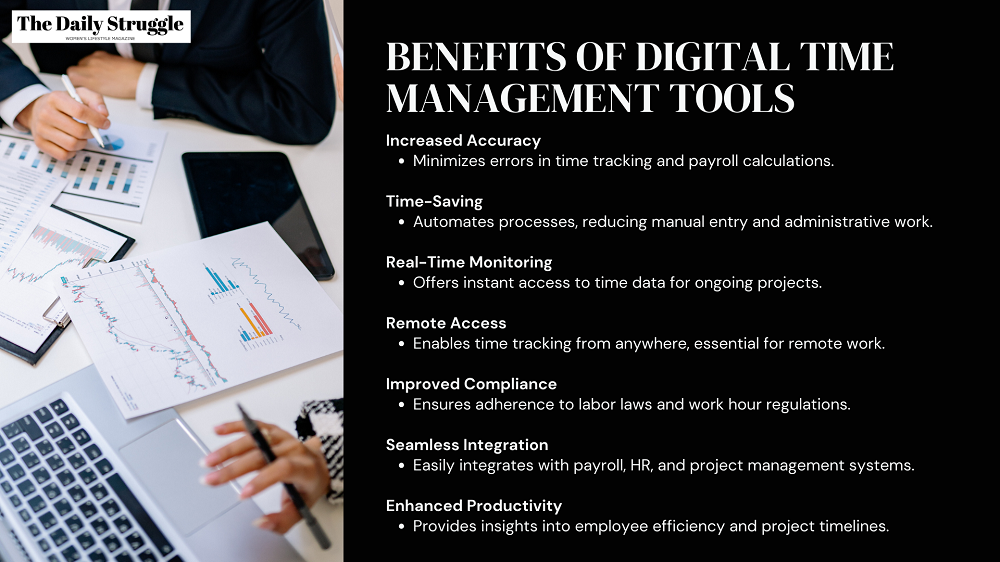
In today’s fast-paced business world, effective time management is crucial for both organizational efficiency and employee satisfaction. Timesheet management, a cornerstone in this process, has undergone a significant transformation with the advent of digital technology. Gone are the days of manual logging and cumbersome paper trails. Modern organizations are increasingly embracing digital timesheet management solutions, recognizing them as superior tools for accurate and efficient tracking of work hours.
This article delves into the world of digital timesheet management, offering insights into its numerous benefits and practical tips for successful implementation.
What is Timesheet Management?
Timesheet management, at its core, is the process of recording and tracking the amount of time an employee spends on various tasks and projects. This practice, essential in numerous industries, serves multiple purposes, from payroll processing to project management and labour law compliance.
Initially, timesheet management involved manual recording of hours on paper. This method, while simple, was prone to errors and inefficiencies. The shift to digital timesheet management marked a significant milestone and improvement.
- This change was driven by the need for more accurate, efficient, and accessible time-tracking methods, which in turn arose from factors like the increase in remote work and home office and stricter labour protection laws.
Digital timesheet management utilizes software and online platforms to record and monitor work hours. These tools often integrate features like automatic time tracking, customizable online timesheets and reports, and real-time data access.
The Digital Revolution in Timesheet Management
The shift to digital timesheet management has been a transformative step in the modernization of workplace practices. This revolution, transitioning from manual, paper-based systems to digital platforms, has fundamentally altered how businesses approach time tracking and management.
- Initially, the transition from paper to pixels was driven by a need for greater accuracy and efficiency.
Digital timesheet systems emerged as a solution to the inherent limitations of manual recording—errors, time-consuming processes, and limited accessibility. As businesses adopted these digital tools, they unlocked new potentials in managing employee time and project allocation:
- Automated Processes
One of the hallmark features of digital timesheet management systems is automated time tracking. This technology not only reduces the need for manual entry but also significantly cuts down on inaccuracies. Employees can now log their hours with a few clicks, and the software automatically populates timesheets, ensuring precise recording and calculations.
This automation extends beyond mere time tracking; it integrates with other business systems such as payroll and human resources, streamlining the entire administrative process and reducing data redundancy.
- Real Time Data & Access
The efficiency of digital timesheets is further enhanced by their real-time data capabilities. Managers and team leaders can access up-to-the-minute reports on employee productivity and project progress. This immediacy of information is invaluable for making informed decisions, adjusting workflows, and managing resources more effectively.
- Remote Time Tracking
Moreover, the flexibility and accessibility of digital timesheet systems have been a game-changer, particularly in the context of the growing trend of remote and hybrid work models. Employees working from various locations can easily log their time, and managers can monitor and manage these entries from anywhere.
Many digital timesheet systems have extended their functionality to mobile devices, enabling on-the-go time tracking and management, which is especially beneficial for field workers and travelling professionals.
- Reporting Features
Another significant advantage brought about by the digital revolution in timesheet management is the enhanced capability for data analysis and reporting. These systems can generate comprehensive reports, providing deep insights into labour trends, project hours, and productivity metrics. Businesses can leverage this data to make strategic decisions, optimize resource allocation, and improve overall operational efficiency.
In summary, the digital revolution in timesheet management has not only streamlined the process of tracking and recording time but also provided businesses with a tool for better strategic planning, enhanced productivity, and more effective project management. This shift has been instrumental in adapting to the evolving demands of the modern workplace, highlighting the critical role of technology in improving business practices.

Tips for Effective Timesheet Management
Effective timesheet management is crucial for streamlining business operations and ensuring accurate payroll and project tracking. To harness the full potential of timesheet management, especially with digital systems, it’s important to follow some best practices. Here are essential tips to enhance the efficiency and effectiveness of your timesheet management process:
- Select the Right Digital Timesheet System: Choose a system that aligns with your business needs, considering factors like size, industry, and specific requirements. Look for user-friendly interfaces, integration capabilities, and customization options.
- Implement a Clear Timesheet Policy: Establish and communicate clear guidelines regarding time tracking. This should include deadlines for submitting timesheets, instructions for logging different types of work, and policies for handling discrepancies.
- Train Employees and Managers: Provide comprehensive training for all users, ensuring that employees know how to use the system effectively and managers understand how to review and approve timesheets.
- Regularly Review and Update Procedures: Periodically assess your timesheet management process. Be open to making adjustments to improve efficiency or address new challenges.
- Automate Reminders and Notifications: Utilize automated reminders to prompt employees to submit their timesheets. This helps in maintaining consistency and reduces the chances of delayed submissions.
- Integrate with Other Business Systems: Sync your timesheet system with other business software like payroll, project management, and HR systems for streamlined operations and better data consistency.
- Encourage Accurate and Prompt Entries: Foster a culture where employees understand the importance of accurately and promptly recording their time. This can be achieved through regular communication and by setting an example at the management level.
- Utilize Reporting and Analytics Features: Leverage the reporting capabilities of your digital timesheet system to gain insights into employee productivity, project progress, and resource allocation.
- Address Discrepancies Swiftly: When discrepancies arise, address them promptly to maintain accuracy in records and trust in the system.
- Ensure Compliance with Legal Standards: Stay informed about labour laws and regulations regarding working hours, and ensure your timesheet management practices comply with these standards.
- Regular Feedback and Open Communication: Encourage feedback from employees and managers about the timesheet system, and be open to suggestions for improvement.
- Maintain Security and Privacy: Ensure that your timesheet system is secure and respects employee privacy, particularly when handling sensitive data.
By incorporating these tips, organizations can create a robust and efficient timesheet management system that not only simplifies time tracking but also contributes to the overall productivity and compliance of the business.
Conclusion
In a rapidly evolving business landscape, effective timesheet management has emerged as a pivotal aspect of operational success. Embracing digital timesheet management solutions has revolutionized this domain, transforming it from a mundane task to a strategic tool that enhances accuracy, efficiency, and compliance. These digital systems, with their automated tracking, real-time data, and seamless integration capabilities, have not only simplified the process of managing work hours but have also opened up avenues for strategic planning and improved project management.
By adopting these innovative solutions and following best practices for effective management, organizations are positioned to reap significant benefits. They can ensure accurate payroll processing, comply with labour laws, and boost overall productivity, all while adapting to the dynamic demands of the modern workplace.

Just a group of real women dealing with life’s daily struggles! Want to write for us? Email: hello@thedailystruggle.co.uk